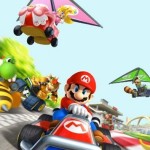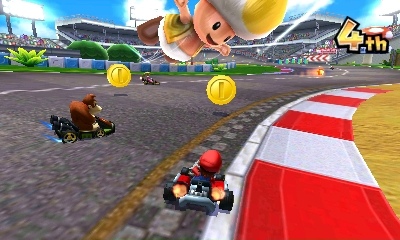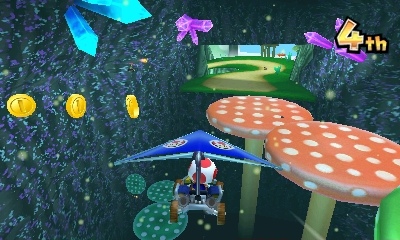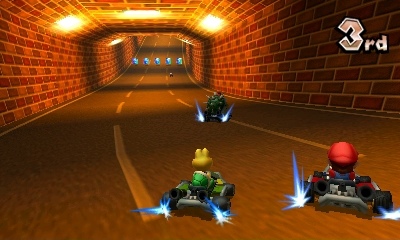
Mario Kart 7 review
It’s always an exciting moment to discover that a new Mario Kart game is on the way. You could argue that Nintendo’s seminal racing franchise has steadfastly refused to budge when it comes to the gameplay that has served it so well since the original Super Mario Kart all those years ago but when the only attempt to veer off from that template resulted in the GameCube effort Mario Kart: Double Dash you can see why the series has stuck so close to its origins on every other occasion. In my view there’s always been enough neat tweaks and additions to the experience to justify the purchase every single time. Of course, nips and tucks as we move from console generation to generation are one thing but hang-gliders and propellers? You’d be forgiven for wondering whether this is a step too far beyond what is expected for Mario Kart.
First things first, the various hang-gliders and propellers that are available to you as you unlock them in-game are deployed automatically with no input from you. Drive off a particularly high ledge or boost off a jump and the hang-glider will pop out, allowing you to gently swoop down to earth using the circle pad to guide your descent. Propellers work in the same way; drive into water and the propeller will pop out from behind you and give you a push through the depths. At first glance these additions seem merely cosmetic but as you play it becomes apparent that they will add to your range of racing tactics in a variety of ways. When you are hang-gliding you can travel quite far down the course if your flying skills are with you on the day, using that opportunity to scout out the road ahead for shortcuts, but you could just as easily push yourself into a nose dive to get back to the real racing. Propellers also give you more scope than first appears. On one of the first courses you’ll play in Gran Prix mode the track narrows down to a thin Y-shaped junction with a big pool of water beyond. Your Mario Kart racing instincts scream at you to avoid falling into the water because you’ll have fallen out of the track and be dumped unceremoniously back onto the course by Lakitu with the lengthy time delay that brings, but the first time I was playing this track I came up to this junction and got smacked from behind with a red shell which caused me to spin out over the edge and straight into the water. Grumbles aplenty from me but rather than seeing the screen fade to black, I recovered from the shell hit straight away underwater, the propeller appeared and I just kept on driving through the pool, up the side and back to rejoin the course further ahead. It completely changes the scope of the tracks and forces you to re-evaluate how you approach them. This allows Nintendo to pull some nifty tricks with course layouts, introducing new ways to tackle tracks rather than just keeping us restrained to the track proper.
The game itself looks as beautiful as you’d expect from a Nintendo release. All the characters look great; enhanced versions of what we saw in Mario Kart DS is how I’d describe it, and the courses are all beautifully rendered with great backdrops. A quick word on the 3D which really is the best I’ve seen to date on the 3DS. The immersion it gives you as you swerve around obstacles and career through the tracks is second to none.
A new feature is the kart customisation screen. Mario Kart DS allowed you to choose from a selection of different karts as you won the various grand prixs but this new 3DS edition takes things a bit further. You choose your character, then the main body of your kart, of which there is a large selection as you compete more and more Grand Prix’s. You’re then given a choice of wheels; small, standard or large. In all honesty, the true racers amongst us are only ever to going to plump for the standard wheels. The small trolley-like wheels are too jittery and sensitive and the big truck wheels make navigating some of the tracks a real lumbering chore. Younger players will have a field day mixing up all the different variations for a kart of their choice but I for one will be sticking with the tried and tested standard kart.
Drifting is present and correct but to begin with it feels loose and floaty on 3DS thanks to the circle pad (D pad control is not an option). Decades spent waggling my thumb over a D pad meant that it took me a little while to get to grips with how the 3DS handles but you’ll soon wonder how you ever struggled in the first place. Something else that makes a return from ‘ye good old days’ (and we’re surprised it’s taken so long to return) is coin collecting in-race, with Mario’s favourite collectibles laid out liberally throughout courses. Keep on grabbing these, up to a maximum of ten, and you’ll get a speed boost. All the items are present and correct and, as is now part of the custom, some new ones have made their way into the game. The tanooki tail lets you swipe away at other drivers or items as you pass them (for example, approach a banana skin and the tail can hit it away so that you don’t slip), the lucky seven gives you seven items that circle your kart. Some will benefit you, others will help out your competitors so it’s a bit of a mixed bag. Finally we have the fire flower which lets you shoot out fireballs; a good one to get if you are in the latter half of the pack.
Single player is you usual assortment of grand prix, time trial and challenge modes and while that is all entertaining enough, multiplayer is obviously the main selling point in every iteration of Mario Kart. In MK7 I have to say it is pretty flawless. The change in Nintendo’s strategy on 3DS to have just one friend code instead of the far more awkward ‘one code per game’ lark makes it so much easier to add your mates and getting a race going is easy, quick and things can be as general or as specific as you like. Want all your races to be on the same course with only bananas? You got it. For those without online friends, going online is still open to you as you can drop into to a whole host of different leagues and it is all great fun. Interaction is limited to a list of pre-chosen phrases that you can click on pre- and post-race, but when the alternative is smack-talk from American kids this is a blessing in disguise. You can also download time trial ghosts via street pass which helps add to the single player content long after you’ve earned gold on all the cups.
A few people are going to be doubtful of the new hang-glider / propeller mechanics and it’s easy to see why, but I feel that their inclusion will be a small but integral part of this latest update. It’s just enough to help keep the series feeling fresh, but it’s not too much of a departure to cause any real concern. Otherwise, the game is pretty much what we’ve come to expect over the years. Expertly balanced racing, albeit mixed in with cheating AI competitors who are ever present on the 150cc cups (I’ve lost track of the amount of races I’ve lost on the last straight after leading the way for the whole race because some bastard has miraculously been given a blue shell) and there are some gorgeous graphics and great use of 3D. Admittedly what we have on offer is not enough to make Mario Kart 7 an essential purchase – if you’ve never been a fan of Mario Kart then this 3DS edition has little to change your opinion – but those who invest the time with it will have great fun. It’s normally a negative to find out that a game is just ‘more of the same’ but when it comes to Mario Kart that’s just what I want!
4/5
Categories: Reviews



0 Comments
This post has been left all alone with no comments. Don't leave it lonesome - give it some company with a comment.